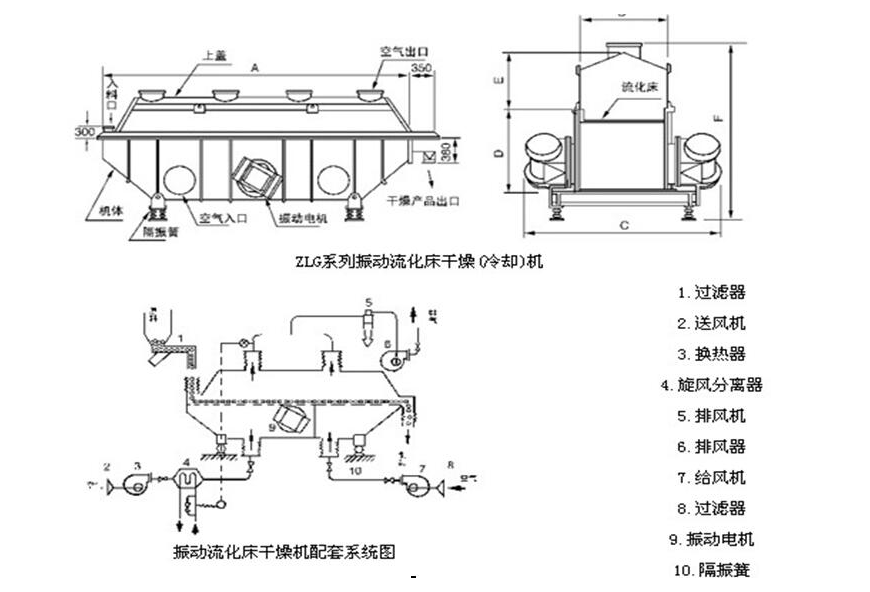1. Material Overview
Nickel sulfate exists in three forms: anhydrous, hexahydrate, and heptahydrate. The commercial product is typically the hexahydrate form, which has two variants: α-type and β-type. The α-type is a blue tetragonal crystal, while the β-type is a green monoclinic crystal. When heated to 103°C, it loses six molecules of crystallization water. Nickel sulfate is easily soluble in water, slightly soluble in ethanol and methanol, and its aqueous solution is acidic. It is slightly soluble in acids and ammonia water and is toxic. Nickel sulfate is mainly used in the electroplating industry, pharmaceutical industry, inorganic industry, and dyeing industry.
2. Overview of Nickel Sulfate Drying Solutions
The material to be dried this time is nickel sulfate, which has strong acidity and corrosiveness. To address these characteristics, our company has upgraded and improved the equipment manufacturing. The upper and lower boxes of the vibrating fluidized bed, as well as the inner wall surface, are fully lined with 3mm fiberglass. The vibrating plate is made of specially processed nickel plate with perforated duckbill holes. All exhaust emissions use high-temperature and corrosion-resistant fiberglass materials. The support frame and support tubes are specially made of carbon steel with Teflon coating. To achieve optimal exhaust results, the bag filter uses bags made of special acid-resistant materials, and even the variable frequency fan for air regulation is made of FRP (Fiber Reinforced Plastic). This process effectively addresses the challenges of high temperature and high corrosion during material drying.
3. Principles of Nickel Sulfate Drying Solutions
The material enters the machine through the feed inlet. Under the excitation force provided by the vibrating motor or other methods, the material jumps and moves forward on the air distribution plate. At the same time, the air is filtered and heated to a certain temperature before entering the lower air chamber of the dryer through the air inlet. Under the combined action of the vibrating force and the hot airflow evenly distributed by the air distribution plate, the material is suspended and contacts the hot airflow. The intense turbulence between the material particles and the heat medium enhances the heat and mass transfer process. The dried product is discharged through the discharge port, and the evaporated moisture and exhaust gas are collected and discharged into the atmosphere after dust recovery by a cyclone separator. The lower bed provides a stable air chamber with a certain pressure for the bed layer. By adjusting the induced draft fan, the upper part of the bed layer in the upper box is maintained at a slight negative pressure to ensure a good drying environment and prevent dust leakage.
1. The material is heated evenly, ensuring thorough heat exchange and high drying intensity, making it about 30% more energy-efficient than ordinary dryers. The vibration source is driven by a vibrating motor, which ensures balanced operation, easy maintenance, low noise, and long service life. The fluidization is stable, with no dead zones or blow-through phenomena. The minimal surface damage to the material makes it suitable for drying fragile items, and irregular particle shapes do not affect the working efficiency.
2. The fully enclosed structure effectively prevents cross-contamination between the material and the air, maintaining a clean operating environment. It has good adjustability and a wide range of applications. The thickness of the material layer, the movement speed within the machine, and the amplitude can all be adjusted steplessly.
3. The application of vibration reduces the minimum fluidization gas velocity, significantly lowering the air demand and, consequently, the dust carryover. This allows for a reduction in the size of auxiliary equipment such as heat sources, fans, and cyclone separators, thus lowering the overall equipment cost and enhancing energy-saving effects. The residence time within the machine can be easily adjusted by changing the vibration parameters. The piston flow operation reduces the requirements for material particle size uniformity and regularity, making it easier to obtain uniformly dried products.

